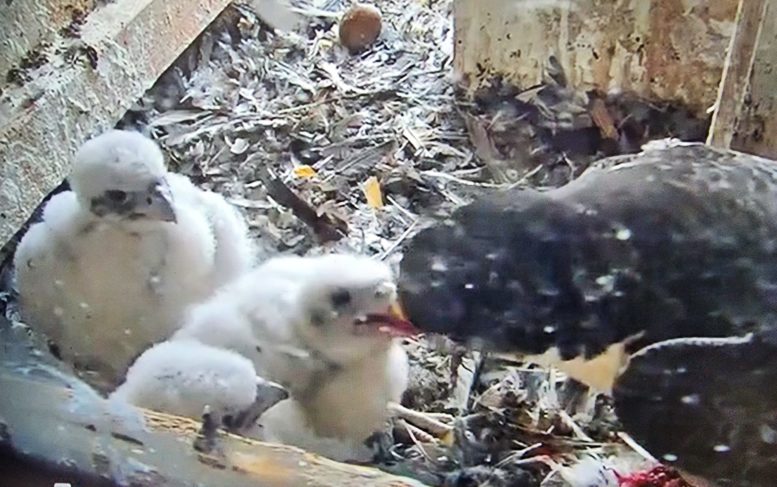Bowling Green’s pair of Peregrine Falcons have once again set up shop in the clock tower of the Wood County Courthouse to expand their family. As of earlier this week, there were four eggs in the clock tower.
Viewers can watch the falcon’s activity through the live Falcon Cam, https://www.bgsu.edu/falconcam?fbclid=IwAR3jSIW5sZiritiYGkuN-NXh5sNptIuIIBcFvD_ZGi-9MwCZr1j62H6BlMI, a partnership between the Wood County Commissioners and BGSU.
This is the 13th year in a row the falcons have chosen this spot to nest.
The Peregrine Falcon is BGSU’s official mascot.
From the Ohio Department of Natural Resources:
- Peregrine falcons are about the size and weight of a crow.
- Peregrines normally grow to 15 inches in length with a 40-inch wingspan.
- The speed of a peregrine has been said to reach 175 miles per hour or more. Experiments conducted by scientists put the bird’s diving speed at approximately 200 miles per hour and level flight at approximately 62 miles per hour.
- Females are larger and more powerful than males. Adults have slate dark blue-gray wings and backs barred with black, pale undersides, white faces with a black stripe on each cheek, and large, dark eyes.
- Their wings are long and pointed.
- Their prey includes ducks, pheasants and pigeons. Biologists are frequently surprised by the variety of species brought to Ohio nests. Remains of meadowlarks, chimney swifts and woodcock show that falcons find many different birds in their urban surroundings.
- Prey is caught in flight. Using its great speed, the falcon delivers a powerful blow to its prey with a half-closed foot. It retrieves the dead bird either in mid-air or after it falls to the ground.
- Although they have a high mortality rate, peregrines have been known to live as long as 15 years.
Nesting Information, courtesy of the ODNR:
- Peregrines usually begin breeding at about 2 years old.
- The nest itself is little more than a shallow scrape, shaped by the birds in soil or accumulated debris. Wildlife biologists frequently provide a gravel-filled tray for city-nesting birds to use.
- The nest holds three or four eggs (slightly smaller than those laid by chickens) that are mottled with a dark, reddish-brown pigment. The eggs hatch in about 33 days.
- Both adults incubate the eggs.
- A young falcon in the nest is called a nestling or an eyass (pronounced EYE-ess). They are covered by white down when they hatch, which is replaced by feathers in three to five weeks.
- Both the adult male and female help care for the nestlings.
- Nestlings eat an incredible amount of food. They double their weight in only six days and at three weeks will be ten times birth size.
- When the young falcons are 3 weeks old, Division of Wildlife biologists examine the birds to determine their sex and take a blood sample used to track DNA and possible chemical contaminants. Biologists also equip each bird with metal leg bands that are used to identify the falcons in the future.
- Around 40 days, young peregrines begin flying. Adult peregrines encourage flight by “baiting” the young with food, which is no longer fed directly to the young.
- The young falcons leave the area where they hatched by the end of summer to disperse and establish a territory of their own, elsewhere.

